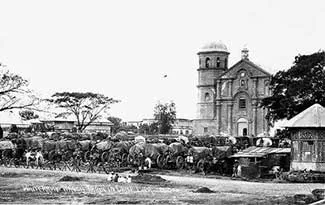The Capture and Looting of Lipa by US Troops in 1900 during the Fil-American War
In December of the year 1899, almost a year after the Philippine-American War had broken out, after clearing the Bulacan towns of Baliuag and San Miguel de Mayumo of Filipino rebels, General Henry Ware Lawton began devising an ambitious plan to sweep down to the south of Luzon, including Batangas1.
Whilst in the middle of his preparations, Lawton was summoned back to Manila by General Elwell Stephen Otis, Military Governor of the Philippines2. If at all Lawton was given the opportunity to discuss the plan with the governor, it was probably disapproved because the former “was forced to cool his heels at Manila for two weeks.”
Afterwards, he was sent to San Mateo in the province of Rizal on “a comparatively minor expedition” – that is, given his rank and stature – to pursue a small group of Filipino rebels. The operation in San Mateo took place in the middle of a typhoon. While the fighting was taking place, Lawton was shot through the lungs just moments after dragging a wounded young officer to safety.
He would expire not long after, and History would remember him as “the highest ranking American officer to fall in battle in either the Spanish-American or Philippine-American wars3.”
 |
| The US Army stationed in front of the Cathedral of San Sebastian. Image souce: Hoosiermarine on Flickr. |
A fortnight after Lawton’s death, Otis “authorized a more conservative execution of Lawton’s plan for dealing with the insurgents in the area south of Manila.” The command of Lawton’s former division4 was transferred to Major General John C. Bates.
The division was divided into two brigades5 under the command of Generals Theodore Schwann and Loyd Wheaton. The two brigades conducted operations in Cavite and Laguna early in January. By 9 January, Cavite was in American hands6.
The following day, the 39th Infantry Regiment under the command of a Colonel Robert L. Bullard defeated a band of Filipino rebels in Santo Tomas, Batangas. Bates sent the 38th Infantry Regiment to reinforce Bullard’s troops, “with instructions to continue south towards the town of Lipa.”
The town erstwhile known for its coffee and even gained the status of a Spanish royal estate as Villa de Lipa was taken by the two regiments on 15 January “after a brisk fight in which the artillery figured prominently…”
One hour after Lipa was captured Bullard and one Colonel Anderson, commander of the 38th Infantry, heard rumors that American prisoners were being held by Filipino rebels in the pueblo or town of Rosario eight kilometers south of Lipa. Acting impulsively, the two quickly organized a small party which also included a lieutenant colonel, a major, a captain, two lieutenants and four enlisted men and rode on horseback for Rosario by mid-afternoon.
Needless to say, no American prisoners were found. However, the group relieved a Spanish officer stationed in the town, and from the latter, they obtained information about $20,000 in funds belonging to the Filipino rebels. They took the money and rode back to Lipa that same afternoon.
In the meantime, while the party was away in Rosario, troops under the command of Bullard and Anderson must have gone house to house, terrorizing the locals and robbing them of their valuables “in violation of all orders.” One Colonel Cornelius Gardner of the 30th Infantry, reporting on Anderson’s 39th Infantry, reported one battalion7 “loaded down” – i.e. weighed down or carrying heavy weight – with “booty from Lipa.”
Bates, Commanding General of the entire division, was unimpressed with the actions of the two colonels and reported:
“This exploit in which two colonels left their regiments in violation of their responsibilities as commanders, in obedience to an impulse of enterprising courage, is so peculiar that it is impossible to praise it without combining rebuke with approbation or to censure it without expression of admiration for the dash and gallantry displayed.”
The behavior of the looters, however, was easier to explain. Majority of the soldiers brought over to the Philippines did not belong to the regular army. Instead, they were “state volunteers” who were shipped overseas to augment the United States Army and were known as the United States Volunteers.
Few of these soldiers had received any military training prior to being shipped overseas and whatever training they received upon conscription was hasty and insufficient. The indiscipline and disregard for orders, therefore, is not difficult to understand.
From Lipa, American troops left for the town of Batangas on 16 January, arriving there that same day despite engaging Filipino rebels in minor skirmishes along the way. Not long after, the Americans started setting up garrisons in the principal towns of Batangas Province.
2 “Elwell Stephen Otis,” Wikipedia.
3 “Henry Ware Lawton,” Wikipedia.
4 A division is “a large military unit or formation, usually consisting of between 10,000 and 20,000 soldiers.” Wikipedia.
5 The number of soldiers in a brigade varies internationally, but a typical NATO brigade consists of 3,200 to 5,500 soldiers. “Brigade,” Wikipedia.
6 This did not mean that the Philippine-American War had ended in Cavite, but only that major towns had been captured by the American and rebel troops captured or scattered and could not reassemble.
7 The number of men in a battalion varies internationally, but can be anything from 300 to 800 men. “Battalion,” Wikipedia.
